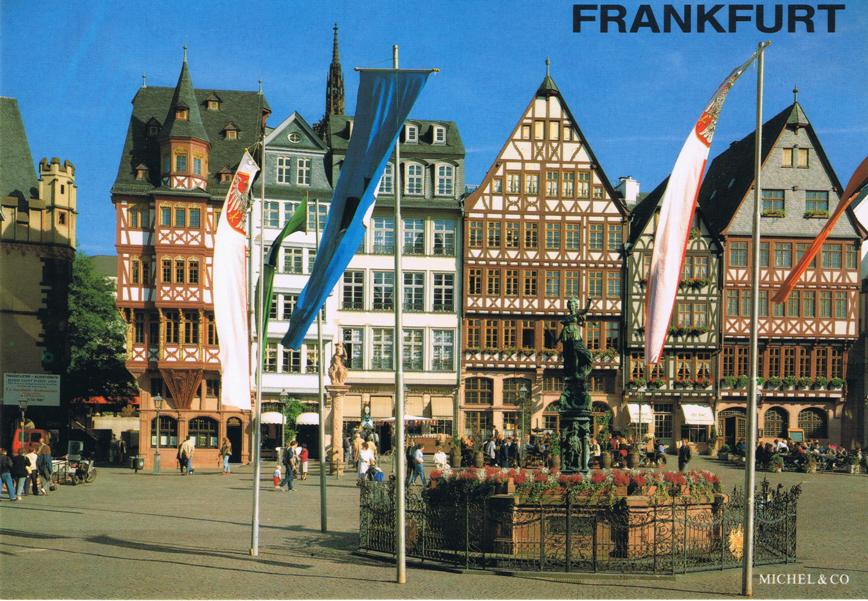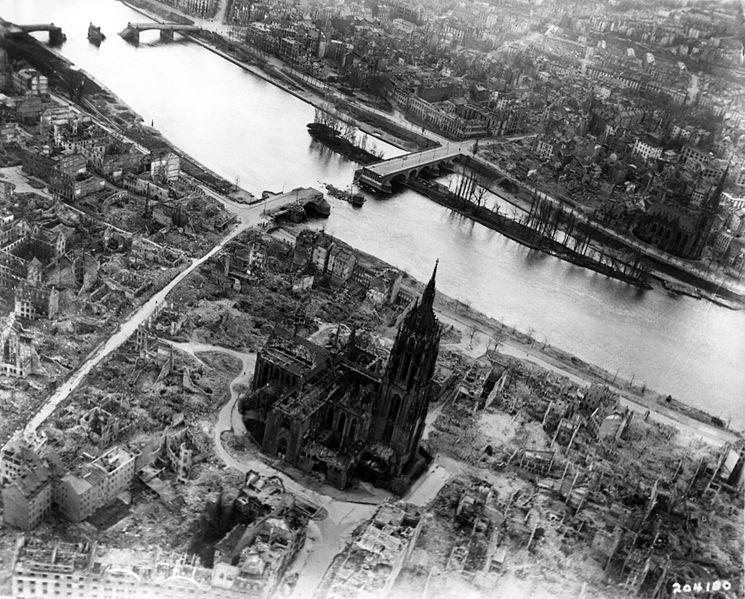The historic main square in Frankfurt is a pretty cobbled place. There are buildings on three sides with black or red timbered faces. There are cast iron sign brackets and from them hang attractive shields emblazoned with the names of traditional German restaurants, the wine cellar, the Black Star, the Stone House. City hall is here and newly married couple after couple appear in front of the traditional ornate facade with their happy families and friends. There is a fountain into which you may toss your change and a tourist information office where you can get a walking map for 50 cents and there are those people who spray themselves silver, don archaic clothing, and stand on milk crates trying to get you to empty your pockets into the hats or little suitcases they have in front of them for the pleasure of having your photo taken with someone who’s sprayed themselves silver and dressed up in a hat with a big feather on it. There is a man on a park bench playing songs on his accordion, lending the right sound track for an attractive traditional German plaza on a sunny day. One corner of the plaza is pinned down with a modest Gothic church. Towering over the whole scene from a block away is the cathedral with its clock tower and spires. It’s picturesque, immaculate; a gloriously preserved late medieval setting where all of your cliches are happily met.

Only a lot of it is new. The attractive line of buildings that marks the east side of the square was built in the 1986 from historical plans.
I was disappointed to learn this. I felt like I’d somehow been tricked. Then, I became annoyed with my own reactions, what was the matter with me that I couldn’t enjoy this traditionally reconstructed square? There were boxes bursting with petunias in bright colors, and a doorman in a cutaway waistcoat and top hat on the steps of town hall and a blue sky and hourly chimes from the cathedral. I wasn’t bothered by the overpriced menus or the graying t-shirts with the German flag on them or even by the Starbuck’s the other side of the trolley tracks. But I was unnerved by the plaza’s newness, it was 400, 500 years younger than I wanted it to be.
Frankfurt had been an industrial center in the period leading up to WWII and was an obvious target. On March 22, 1944, the old city of Frankfurt was bombed. 1000 people were killed and much of the old city was destroyed. It was bombed again on December 11. Statistics say approximately 5500 people total died from these bombings, but they don’t include the displaced who must have died elsewhere, or the minorities and Jews systematically murdered prior to the Allied attacks. Of course the plaza was new, it had been bombed to near oblivion in the 40s.

Frankfurt is a boom town now, cranes punch holes into the sky. I enjoyed being there, I liked my quiet hotel and its predictably amazing German buffet breakfast, I liked the somewhat pricy but immaculate indoor farmer’s market, I liked seeing all the different kinds of people on the streets — it’s surprisingly diverse. I liked the clouds of Chinese and Korean tourists and the ridiculous giant statue of the Euro sitting in the middle of a plaza surrounded by big modern banks. I liked walking the shopping district in the muggy spring heat, watching girls with department store bags and boys with headphones on, ladies in burkahs and ladies in summer shorts and tank tops. It felt like a real place to me, a working city. Not far from where I stayed was a street lined with bridal shops, confectionery dresses on mannequins in the windows, and another short street that served as an abbreviated sort of Chinatown.
My brother met me in Frankfurt the morning we were to depart on a trip up the Rhine River. “Have you been to the main plaza?” I asked him, and he described the modern shopping district a few blocks in the other direction. “Wrong plaza, let’s go have a look. It’s just a short walk from here.”
“It’s very pretty,” he said, as we stood in the mostly empty square. It was early, most of the touristy businesses, save the cafe on one corner and the Starbuck’s across the street, were closed.
“It was built in the 1980s,” I said.
“They did a nice job.”
At our feet was a memorial to a book burning that had taken place under the Nazis. It says, “Das war ein Vorspiel nur, dort wo man Bücher verbrennt, verbrennt man auch am Ende Menschen.” Roughly translated: This is only a preview; where man burns books, he will soon burn people, too.
Across the plaza, the souvenir stands were opening, vendors were rolling out racks of postcards and those dusty t-shirts.
Much of Frankfurt’s old city plaza was built in the mid 1980s. The old quarter is under expansion, it will be all new construction with a nod to the medieval style. It is touristy and pretty and once I’d placed the city in historical context, I got over myself and enjoyed the timbered buildings, the flower boxes, the cobblestones, the fountain, and the fact that Frankfurt is rebuilding itself without erasing its history.
“They did do a nice job,” I said. “Let’s go look at the souvenirs.”
All images via Creative Commons.

I was in Frankfurt briefly this fall and I had the exact same reaction to the plaza–and to the city. Everything said the city wasn’t worth a stop but I spent an afternoon before my flight out wandering the streets from the plaza, across the river, up to the top of the very modern mall, grabbing dinner at the weekly farmer’s market (outdoor) and food festival. The city felt vibrant and energetic. The plaza gave a glimpse to the city that was, but also to the city that is. I loved it.
Unfortunately there is too much of Germany that is exactly the same way! War wreaked havoc on the beautiful cities in this country. I’ve been to the Frankfurt airport many times but have yet to venture to its old town – a situation that needs to be remedied!
So glad to read this- we reacted to Frankfurt the exact same way. Have you been to Berlin? That’s one German city we LOVE 🙂